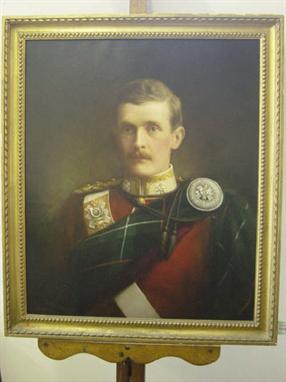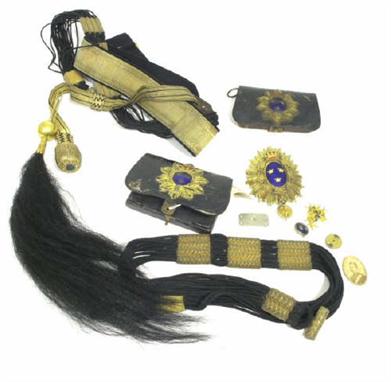We found 9989 price guide item(s) matching your search
There are 9989 lots that match your search criteria. Subscribe now to get instant access to the full price guide service.
Click here to subscribe- List
- Grid
-
9989 item(s)/page
A diamond sautoir, composed of tapered and rectangular links suspending an open work canted rectangular pendant, of geometric design, set throughout with single and brilliant cut diamonds (convertible to a brooch and four separate bracelets), contained in a later fitted case Lengths: chain 71cm; pendant 6.7cm The sautoir takes it's name from the way it is worn, originally inspired by French military uniform of the late 18th century where a necklace worn 'en sautoir' was worn diagonally across the chest in a similar way to a sash. Over the years, the sautoir evolved into a long necklace or chain extending down to or below the waist, with a pendant in the form of a plaque or medal and later a tassel. The sautoir as a piece of jewellery reached its fashion zenith during the Edwardian era and was often composed of seed pearls, woven or twisted with tassel terminals, their delicacy suiting the stylish and elegant silhouette of the time. In the 1920s the sautoir was a vital accessory and ideally complimented the fashion of wearing low-waisted dresses. It was during that period that differing materials were used in their composition including chain links of diamonds of differing designs but always with the popular geometric style of the Art Deco period. They often suspended geometric pendants, or tassels made of pearls or precious stone beads and often had diamond connections. This wonderful sautoir, which splits to form four separate diamond bracelets and a plaque brooch, is so evocative of the Art Deco period and is a good illustration of the geometric motifs found not only in the jewellery of that time, but in house furnishings, art works, architecture and clothing.
A Group of Four Miniatures, in a Decorative Ormolu Strut Frame], comprising a gentleman, circa 1770, with powdered hair wearing a blue coat and lace jabot, oval, 3.6cm by 2.9cm, the frame set with garnets to the border; a lady circa 1770, a feather in her brown hair, pearl choker, wearing a blue dress with bouquet at her bosom, oval, 4.2cm by 3.5cm; a lady circa 1800, looking to dexter, with powdered curly hair, her white dress with ruffled choker, against a sky background, oval, 4.7cm by 3.5cm; and a lady circa 1830, with curling brown hair, wearing a low cut white dress with blue sash, red drape interior background, oval, 7.6cm by 6.1cm, in a ribbon tied laurel leaf oval strut-back frame, 31cm overall
A 19th century Staffordshire figure of King John, signing the Magna Carta, in a tented canopy, flanked by two attendants, 31cm high; and other Staffordshire figures, comprising: an equestrian figure entitled 'Garibaldi', 28cm high; a figure of a blind musician holding a violin, with his dog, 29cm high; a pair of figures, he dressed in a kilt, she with a sash, both standing beside a cannon with drums and flags, 26cm high; and another similar female figure (6)
A Russian porcelain figure of a gentleman, in a black broad brimmed hat, long blue coat and red sash, on a square base, 19cm high; a small female figure of a lady with a gilt flowered head-dress, and a blue smock, one arm raised, 14cm high; and a Continental figure of a female vegetable seller, in a flower sprigged dress and carrying a basket of vegetables, with a further basket at her feet, 20cm high (3)
A group of eight George VI and Elizabeth II medals "To No. 6284496 Private (later Colour Sergeant) John Edwin Seymour, The Buffs", comprising - George VI General Service medal with bar "Palestine", 1939/45 Star, France and Germany Star, Defence medal, War medal, Elizabeth II Africa General Service medal, with bar "Kenya", Elizabeth II Coronation medal, and a George VI Long Service & Good Conduct medal with suspender "Regular Army" (all Court mounted), complete with Certificate of Service 1930-1965, a selection of buttons, flashes, souvenir booklets and photographs, and a Colour Sergeant’s sash
A pair of Dubois flasks in the shape of Turks and an incense-burner modelled as a seated Turk circa 1840-1850 dressed in elaborate oriental fashion, the detailing on his shield, sash and sword in heightened gold, both standing on a pillow with elaborate gilding, their turbans disguising the flask-opening, the other turk reclining against naturalistic rockwork his upper body functioning as the cover, the rockwork opened at the back for a light Dubois in underglaze-blue on the pair of flasks 27.5cm., 10.75;in. the seated Turk with restoration to the back, some typical rubbing of the enamel colours (3)
A contemporary watercolour of the Duke of Wellington in old age, half length, in civilian dress with blue Garter sash, signed G. Dyer 1851, 7” x 8” in moulded gilt frame, Good Condition (minor wear to frame) Plate 14. Note: Original pencil and colour work drawing taken from M. Claudet’s Daguerreotype portrait of Queen Victoria’s historical engraver H T Ryall also engraved Claudet’s daguerreotype. Published by J Watson Vere St, Cavendish Sq London May 1st 1845.
A Victorian mahogany metamorphic dumb waiter of rounded rectangular form above a shallow frieze opening to reveal two extra tiers on rectangular tapered end supports and scrolled bar supports with turned bun feet and brass castors united by a turned pole stretcher in need of a replacement sash 74cm high closed 122cm wide 54cm deep
A First World War Trio, comprising 1914-15 Star, British War Medal and Victory Medal, awarded to 1853 CPL.J.P.GILL.W.YORK.R.; two silver Leeds Hospital Gala medals 1889 & 1891; a French silver medallion for the visit of Mr. Carnot President of the Republic to Ville de Bethune; a silk sash hung with a silver and silver gilt Imperial Eagle pendant; a Masonic ceremonial sword; and a photograph of the Prince of Wales, later Edward VIII, reviewing the troops at York 1923
TWO PAIRS OF 19TH-CENTURY FURNITURE RESTS OR SASH WINDOW STOPS, the first of honey-glazed earthenware moulded with lion masks, hollow based, 11cm wide x 13.5cm high, (4.3in x 5.3in), the second pair in brown stoneware incised with human masks, 8cm wide x 11.5cm high, (3.2in x 4.5in); a single example modelled as a spaniel's head in brown stoneware, 8cm wide x 10cm high, (3.2in x 4in), a sixth, in treacle-glazed stoneware modelled with a bearded male mask, 7.2cm x 13.5cn, (2.9in x 5.3in), and a stoneware bust of a smiling man with hat and bow tie, hollow-based, 18.5cm, (7.3in) high (damage) (7)
A good late 19th century Meissen equestrian figure of Elizabeth of Russia, after KŠendler, seated on a dappled stallion, wearing black tricorn hat, green jacket braided in gold, pink sash and the Order of St. Andrew, holding a baton, a holster pistol at her side, attended by a blackamoor, on a naturalistically moulded oval base encrusted with flowers, 24cm wide, crossed swords mark in underglaze blue, incised no. 1059 and 122 (some faults)
A carved Dieppe ivory Corpus Christi, 19th century, the dying Christ with crown of thorns below a sash marked 'INRI' and on ebony cross with stepped plinth within an elaborate carved gothic wall case, with pierced brackets and spearhead and crucifix finials, the figure 8.5" high, the case 41" high
-
9989 item(s)/page







![A Group of Four Miniatures, in a Decorative Ormolu Strut Frame], comprising a gentleman, circa 1770, with powdered hair wear](http://lot-images.atgmedia.com/SR/10041/2669547/432-63-10041_468x382.jpg)






















